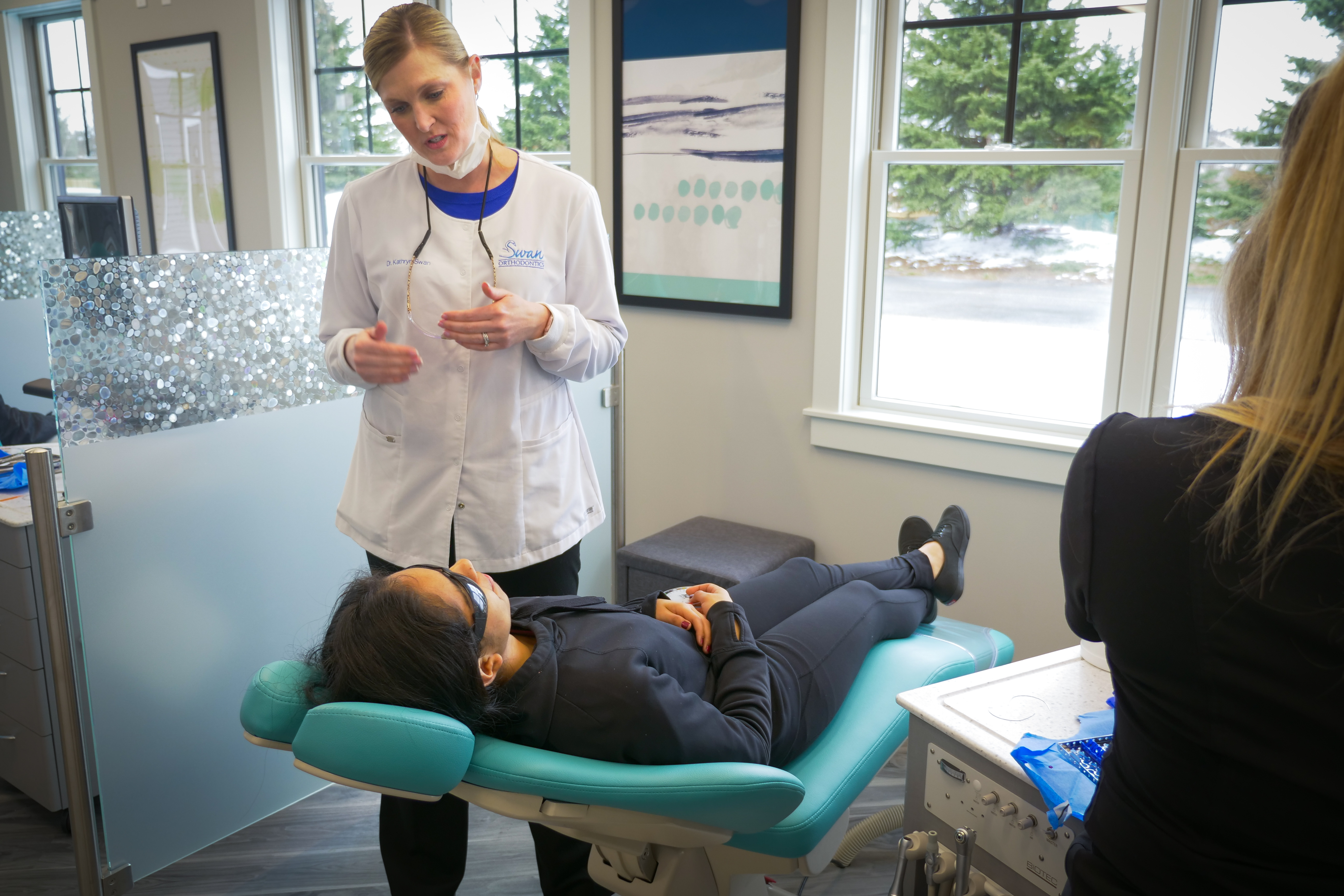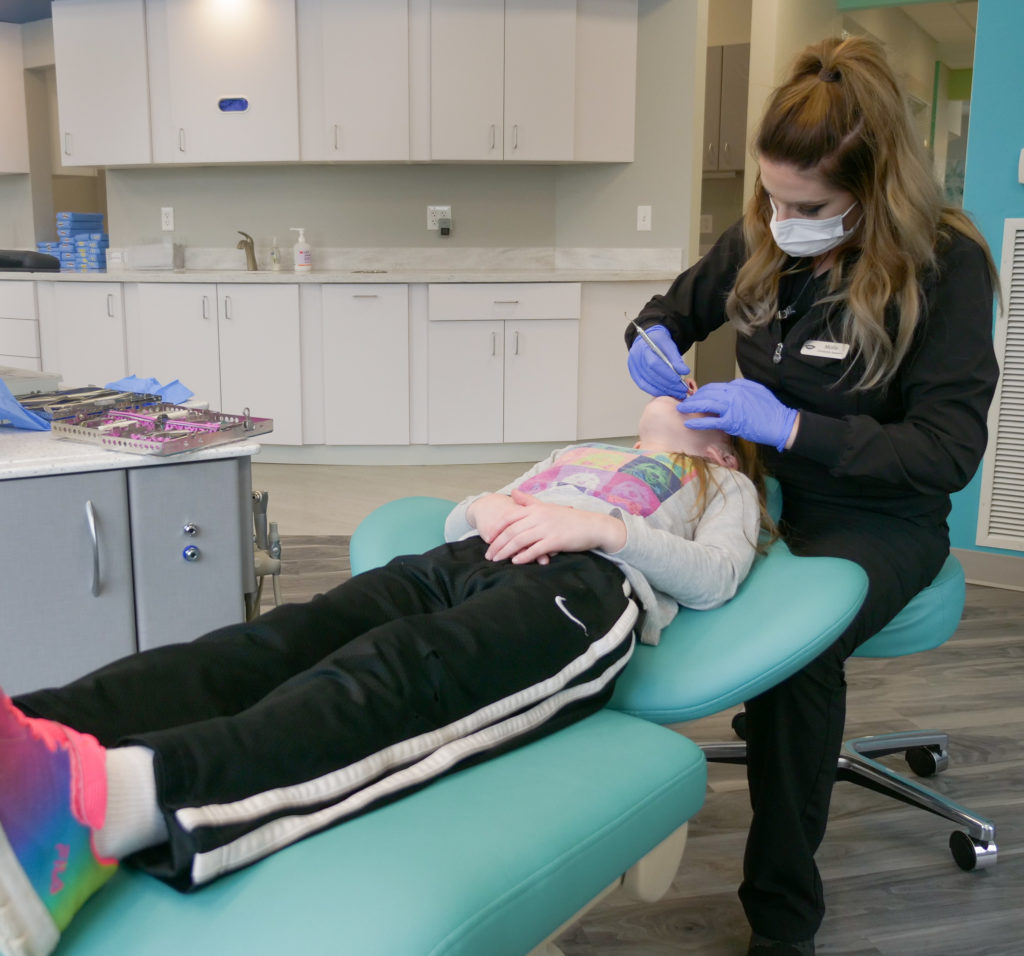When orthodontic treatment is on the horizon for you or your child, it can feel a little overwhelming. Many of our patients have a number of questions and concerns before embarking on their orthodontic journey, including:
- What is the exact cause of the problem?
- How can orthodontic treatment correct it?
- Which treatments are recommended for this particular issue?
- Which would be most effective?
- Is one type of treatment more affordable than another?
- What is the difference between popular orthodontic treatments like traditional braces and the
- Invisalign clear aligner system?
At Swan Orthodontics, we encourage all of our patients to be educated and informed about the process. Although we offer a variety of treatments, traditional braces and Invisalign tend to be our two most popular options. Both are designed to straighten your teeth over time, give you a beautifully aligned smile, and even improve your oral health. We’ll take a look at the pros and cons of each below to help give you the information needed to determine which of these options could be the best fit for you and your smile!
Different approach, same results
Traditional braces have been used in orthodontics for a long time, and as such, have a well-established history of success. They are normally composed of metal or ceramic brackets that are attached to the teeth, then tied together by wires and tiny rubber bands or elastics. With regular adjustments from Dr. Swan, and gentle pressure over time, braces will gradually move the teeth into the desired positions. Modern braces are sleeker, more stylish, and far more comfortable than previous models. They can also be customized with multi-colored brackets and bands, giving patients the chance to showcase their personality! For those who prefer a more discreet look, we offer clear and tooth-colored brackets.
Invisalign, on the other hand, doesn’t rely on a fixed orthodontic appliance like braces. The system instead uses a series of removable aligners that are nearly invisible. These clear trays are made of comfortable plastic material, and have small, tooth-colored attachments that fit over the teeth snugly but comfortably. The custom-made aligners will generally be switched every 1-2 weeks for the next in the series as your teeth gently move into their new and improved positions.
Traditional Braces
The most obvious difference between braces and Invisalign is that braces cannot be removed until treatment is complete. These fixed appliances are extremely efficient at correcting oral issues ranging from mild to complex. They also sometimes work faster to close gaps and straighten teeth than clear aligners like Invisalign. This may shorten the overall treatment time, which averages anywhere from 1 to 2 years, but this will always vary on a case-by-case basis. With traditional braces, you’ll often be able to see some signs of improvement in a relatively short period of time. Sometimes seeing even a slight improvement in your smile can give you a boost of encouragement during your orthodontic journey!
Maintenance with metal braces can be a bit of a challenge, especially in the early days of treatment. A good dental hygiene routine is important for orthodontic patients to maintain, but getting the brackets and wires completely clean can be tricky. Food particles can get stuck in the various nooks and crannies, giving bad bacteria a place to flourish. Fortunately, there are a number of products available that can make cleaning much easier! Oral irrigators are designed to help flush out those hard to reach places, and ortho-picks are great for flossing in and around braces.
Food restrictions are often one of the biggest learning curves that come with braces. You’ll need to avoid anything too crunchy or chewy until you finish up your treatment, including things like certain raw fruits and veggies, popcorn, gum, nuts, and several types of candy and sweets.
When you’re in braces, follow-up visits are an important part of the treatment process, so you can expect to see Dr. Swan every 4-8 weeks or so. During these adjustment appointments, Dr. Swan will change the bands that are attached to the brackets, and may replace the wire as well. We aim to keep these appointments as short as possible, so you can get back to work, home, or school quickly. Although you may experience some slight soreness after each adjustment, it should only be temporary. Do your best to not miss any of these follow-up visits, as they are a crucial part of your treatment plan, and help ensure you get the best results in the least amount of time.
Invisalign
When compared to traditional braces, Invisalign is a relatively new method of treatment. However, it’s proven to be incredibly popular with both patients and orthodontists! This is hardly surprising when you consider the freedom and flexibility available with the system. The aligners are a convenient and efficient method for gently moving the teeth, particularly in cases that aren’t too complicated or severe, and the clear, smooth plastic doesn’t tend to irritate the gums or cheeks the way brackets and wires can.
Even though the end results are the same, Invisalign uses a less invasive way to straighten the teeth. To keep teeth moving the way we want them to, the trays are changed out every week or two for the next in the series. While there’s no one-size-fits-all answer to how long a patient will need to wear the aligners, the average tends to be similar to braces, usually around 1-2 years, though in some cases it may be less. This varies widely from case to case, and unlike braces, user compliance a big factor in the success of Invisalign treatment. The system can only work if the recommended guidelines are followed exactly. Failing to wear the aligners the required 20-22 hours every day can impede the results and also add time to the overall orthodontic process.
Invisalign aligners are extremely easy to maintain because they’re designed to be removed before eating or drinking anything other than water. This means no worrying about food and other debris getting stuck in between the brackets and wires, thus no food restrictions! You also take them out before brushing and flossing, so dental hygiene is as easy as ever.
As an Invisalign patient, follow-up visits will be about every 6-8 weeks, and you’ll be responsible for changing your aligner at the interval recommended by Dr. Swan. Changing your aligners frequently allows us to keep up with your shifting teeth as they straighten out. Skipping or rescheduling appointments frequently, along with not changing your aligners when you’re scheduled to, can quickly undo any progress we’ve made with your smile.
Choosing the right treatment for your smile with Swan Orthodontics
When you consider all the pros and cons of braces and Invisalign, it’s clear both are excellent options for straightening your smile and improving your oral health! It’s worth noting that for some particularly complex dental issues, Invisalign may not be an option, but in many cases, it will be. This is one reason why it is so important to work with an experienced orthodontist like Dr. Swan. She is skilled in creating customized treatment plans for each patient based on their individual case, resulting in a beautifully aligned smile that’s just right for your face!
If you’re in Grand Rapids, Caledonia, or the surrounding areas, and want to know more about how braces or Invisalign can change your smile for the better, get in touch with us today and let us schedule a free consultation for you. We’ll help you find the most effective solution for your orthodontic issues and create a smile you’ll want to share with the world!



